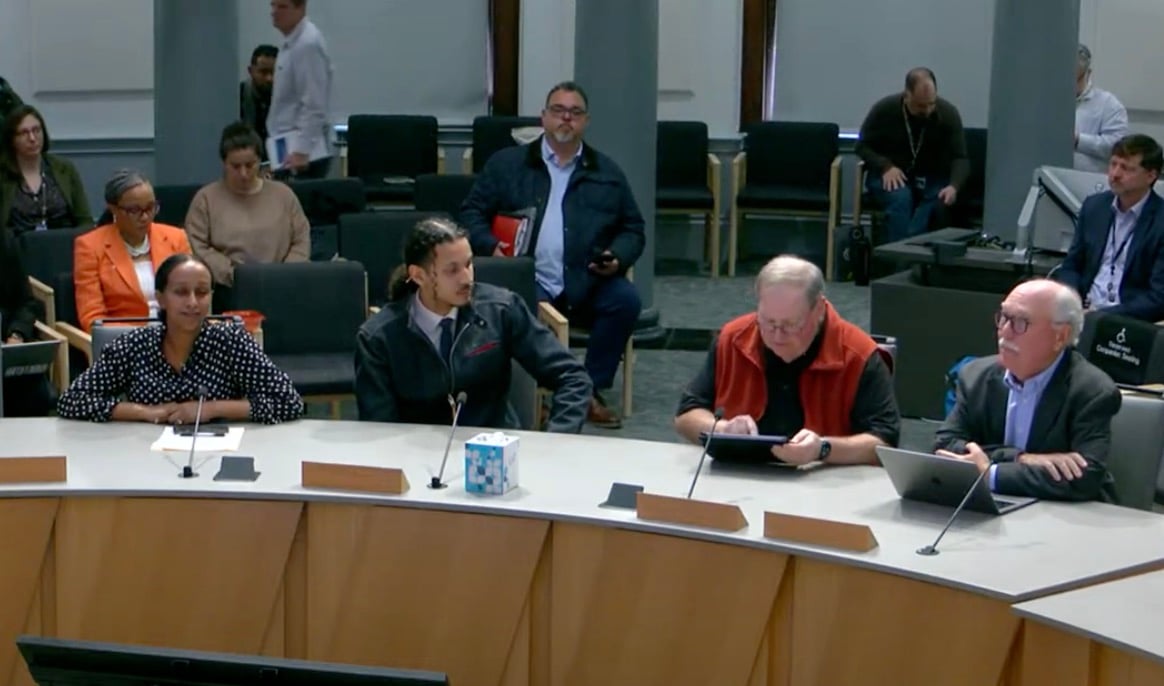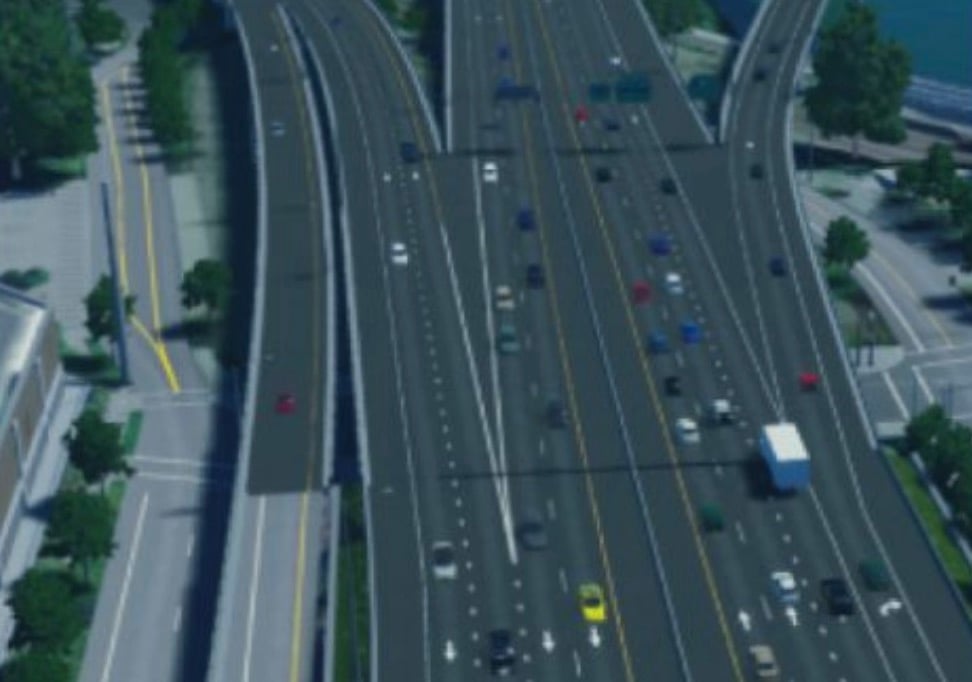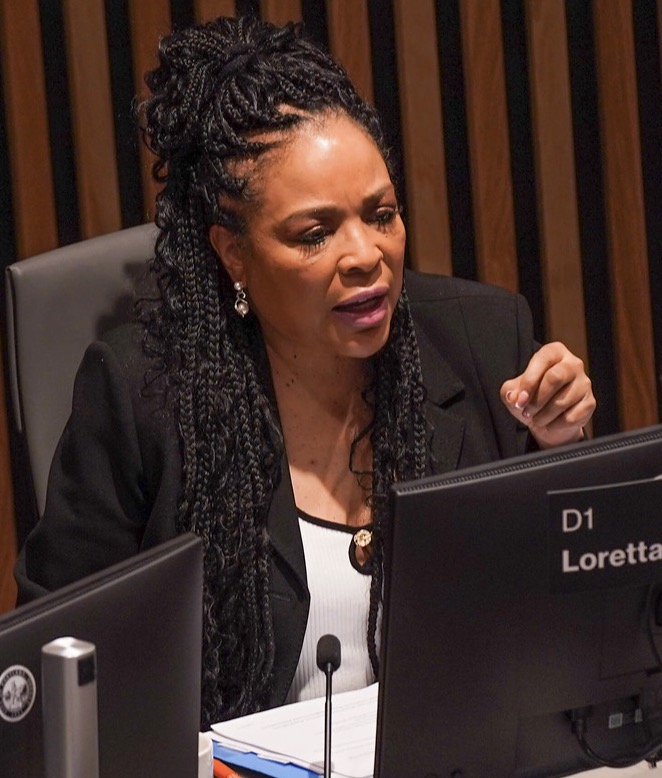
Advocates for and against the I-5 Rose Quarter project had a rare opportunity to voice their perspectives at Portland City Council on Monday. But it wasn’t a fair debate, as city councilors Loretta Smith and Olivia Clark were clearly in favor of one side and were deeply skeptical of the other.
Members of the Transportation & Infrastructure Committee heard from leaders of nonprofits Albina Vision Trust (AVT) and No More Freeways (NMF) as part of an agenda item organized by City Councilor and Vice-Chair of the Transportation and Infrastructure Committee, Angelita Morillo. AVT has emerged as a powerful force in the Rose Quarter since it first came on the scene in 2017 with a plan to re-establish the neighborhood around the Moda Center that was destroyed by construction of I-5. NMF is a grassroots organization trying to stop and/or dramatically reform ODOT’s plans. The lack of any industry representatives or transportation agency staffers was by design. Morillo said at the outset that she felt it was important to have these “different community perspectives” offered by AVT and NMF at the table, “Because we often hear from industry and other voices a lot.”
But two of Morillo’s colleagues on the committee — councilors Loretta Smith and T&I Committee Chair Olivia Clark — clearly didn’t agree. They not only lamented the absence of project leaders from the Oregon Department of Transportation (ODOT) and Portland Bureau of Transportation (PBOT), they were clearly on the side of AVT, a nonprofit working to redevelop Rose Quarter neighborhoods that strongly supports the I-5 Rose Quarter project’s highway lids and expanded freeway lanes. This bias for AVT and the project in general manifested in part by how Clark and Smith treated NMF co-founders Chris Smith and Joe Cortright, both of whom were invited to testify.
The hearing began with AVT Executive Director Winta Yohannes. Yohannes used her time to clarify her organization’s position on the controversial project. She knows there are many Portlanders who are excited about plans to build a new neighborhood on lids over I-5 through the Rose Quarter; but who strongly oppose other project elements that would increase auto capacity by widening I-5 between I-84 and I-405. AVT’s support of the project, “is rooted in our very clear and deep understanding of trade-offs of project components,” Yohannes said. For AVT, the benefits of the estimated (and likely to be higher) $1.9 billion project outweigh the possible harms. Yohannes also knows that the $450 million federal grant to build the project (which would not have been awarded without AVT) would be in jeopardy of the widening elements were stripped away.
“This project represents the braiding of climate, community and statewide economic development goals,” Yohannes told the committee. “At this point, we ask that you continue to stand with us, not us a rubber stamp for a project, but as vigilant partners committed to forward momentum. We do not want to see this council be the one that snatches defeat from the jaws of victory on a project that represents over a decade of hard-earned work and community building.”
Before Yohannes and her co-testifier, AVT Director of Government Affairs & Communications JT Flowers, completed their remarks, Yohannes shared one last comment — one that directly undercut the testimony that would come next from No More Freeways.
“One last note here about the slogan, ‘Lids not lanes.’.. There is no highway cover without a complete project… so unless you know someone has a secret plan for delivering just the covers [and not the lanes], I want to be really realistic and just honest on the record and saying that that is not a real position.,” Yohannes shared.
At that point, and with an eye on the clock, Councilor Morillo suggested having NMF reps Cortight and Smith give their presention, so that both groups would have equal time to share their remarks and a Q & A with the committee could be held after hearing information from both sides. But Committee Chair Clark overruled Morillo and allowed a discussion to begin.
Councilor Loretta Smith was the first to speak. She was glad Yohannes and Flowers made a clear argument that the lids and lanes were inseparable and said, “I think the public is getting confused as if we could [just] do the lids.” Smith wanted to get a clarification on the record so she asked Flowers, point-blank: “Do you think we can do these lids without doing the whole project?”
“There’s absolutely no path, financially or politically, to developing a highway cover without the expansion of the freeway,” Flowers replied.
Smith was pleased to hear that and quickly accepted it as incontrovertible fact. Smith might be so accepting of AVT’s views because she appears to have worked for them in the past. Smith is a registered lobbyist with the State of Oregon via her Dream Big Communications company, which she lists on LinkedIn as being principal of from 2019 to the present. According to state records from the Office of Government Ethics Commission, Smith lists AVT as one of her clients as of January, 2024.
(UPDATE, 2:00 pm: In a phone call with BikePortland today, Smith confirmed she was hired by AVT last year to help them earn $25 million in state funding for a housing development. Asked if her conduct at Monday’s meeting was influenced in any way by her prior relationship with AVT, Smith said “No, because I didn’t work on [the I-5 Rose Quarter Project]. They have different people who work on different projects. I never worked on the I-5 Rose Quarter.” Then Smith added, “Don’t make something out of nothing. This is no big deal… I don’t appreciate you trying to check me on this. You can try to write something up, but I would be very careful [then laughed a few times] about how you characterize my interaction [with AVT] as being favorable. It is not a good thing to do just because you are more favorable, obviously, to the other group.” “I never said that,” I replied. To which Smith said, “Well, you’re calling me on something, so you must be favorable to the other group.”)
After hearing Flowers response, Smith said the public must be “confused,” she implied that anyone who says otherwise is spreading “misinformation,” and she characterized NMF’s concerns that the actual freeway ODOT wants to build could be much wider than they’re letting on as, “totally ridiculous.”
“I wish ODOT was here to be able to tell their story,” Smith lamented. “I want the misinformation to stop. I want people to tell the truth about the project and not confuse it.” These comments shocked me as I listened in real time. I’ve never heard anyone cast such aspersions on the work of Chris Smith or Joe Cortright, two widely respected advocates who’ve devoted countless hours to their work on this project. And Councilor Smith’s initial comments were just a precursor to what was to come.
In his presentation, NMF Co-founder Chris Smith laid out his organization’s concerns with the project and attempted to get the new council members up to speed. NMF believes any investment in widening freeways is “adding more harm that could go to proactive investments like transit, walking, biking, that could reduce greenhouse gasses,” Smith said. NMF is suing ODOT to force them to do a comprehensive alternatives analysis that would consider whether congestion pricing and/or transit upgrades could alleviate traffic concerns in lieu of lane widening. “We have never had a full alternative analysis at that level,” Smith explained.
And he also responded directly to Yohannes’ assertion that “Lids not lanes” is not a real position. “We do believe in ‘Lids not lanes,'” Smith said. “And if ODOT won’t allow us to imagine a project that will do that, we need a better political imagination.”
Smith then passed it over to his fellow NMF co-founder, economist and City Observatory publisher, Joe Cortright.


Cortright shared graphics of a massive freeway (above), much wider than anything ODOT has shared publicly for many years (this project has been bouncing around since 2012, but its current form took shape in 2017). The images came from ODOT themselves and NMF acquired them through public records requests. “This is something they never show anymore, because what they’re really proposing is a massive freeway-widening project,” Cortright explained against the backdrop of a freeway rendering and a technical cross-section drawing created by ODOT that puts the total width of the freeway at 162 feet. “ODOT is proposing is to essentially double the width — and in some cases triple the width of I-5 through the Rose Quarter.”
Cortright also pointed out that independent consultants hired by ODOT as part of their analysis of the highway covers told the state agency they could narrow the planned freeway widening by 40-feet and still achieve project goals. Then, as Cortright warned the committee that once ODOT gets shovels in the ground (a “classic Robert Moses technique from the 1930s” he said), the city and other partners would be obligated to build the entire project no matter the costs (which Cortright believes will be much higher than the $1.9 billion estimated today (of which a $1 billion gap still remains)) — Committee Chair Clark cut him off and told him it was time to wrap up.
After an abrupt ending to their presentation, Councilor Clark was first to respond. “I think some of the data you’re talking about is outdated,” she said, in reference to Cortright’s claims that ODOT plans a much wider freeway than what’s proposed. She then said she would have PBOT and ODOT come to the committee to “rectify some of the misunderstandings here.”
“I appreciate your passion,” Clark added, before trying to pass the baton to Councilor Smith.
But NMF’s Smith forcefully interjected: “The physical dimensions are correct. The striping underneath is a matter of opinion about what ODOT would do in future.”
“We’ll wait for to hear from ODOT and PBOT,” Clark replied, in what felt like an attempt to quiet the NMF advocate.
Then Councilor Smith began her questioning. She implied they weren’t ODOT documents because she didn’t see the ODOT logo on them. When Chris Smith reiterated they were indeed authentic ODOT documents, Councilor Smith not only waved-away Smith’s comment, she dressed him down. “I agree with the Chair. That is outdated information and that’s really unfair and disingenuous of you to bring it here as if it was released yesterday.” (Asked in a phone call today how she knows the doc is outdated, Smith replied, “ODOT said it’s outdated.”)
Then the councilor asked: “Do you think you can actually do the lids without expanding the freeway?” As NMF’s Smith answered and Cortright attempted to add some context of his own, Councilor Smith spoke over Cortright, saying, “Excuse me, you don’t have the floor. I do.”
With Cortright silenced, Councilor Smith asked again: “Now, could you please answer the question Chris? That’s what I’m asking you — not your political, environmental plan — I’m just asking you, as it stands right now, can we do the lids without doing the freeways?”
“The goal of a full EIS [the larger alternatives analysis called for in NMF’s lawsuit] is to answer that question,” Smith responded.
“Thank you,” Councilor Smith replied. “I would appreciate, when you come to this this committee, that you give us real information and not what you would hope. That is a question I would ask ODOT if they were here.”
It’s unlikely Smith would get a clear answer from ODOT either, but according to documents currently published on the official project website, the width would be even wider than what Cortright shared at the council meeting. Asked about the exchange via text message after the hearing, Chris Smith told BikePortland, “It’s frustrating they’re focusing on the date of the document and not the width of the freeway.”
When Cortright spoke up to remind Councilor Smith that ODOT’s own consultants said the freeway could be narrower, Councilor Smith said, “But you don’t want any freeway, whether it’s narrow or wide, so it wouldn’t matter if it’s a narrow freeway or not.”
“I don’t think we said that,” Cortright replied, and then Councilor Clark cut off the exchange and gave Councilor Mitch Green the floor. Green stated his strong opposition to the project, saying he’d rather invest in better transit service instead of more lanes and that he doesn’t trust ODOT to be fiscally responsible.
After that, Clark closed the hearing.
Watch the meeting below. The player starts at the end of Chris Smith’s presentation:






